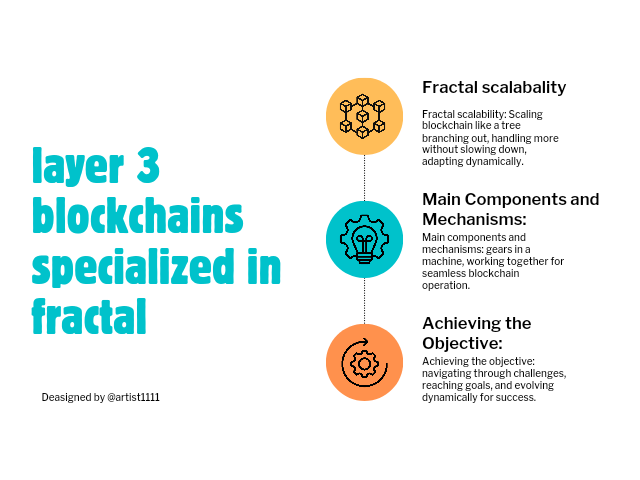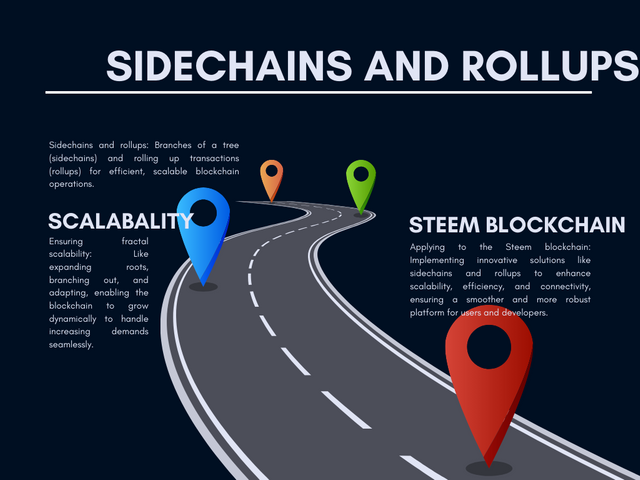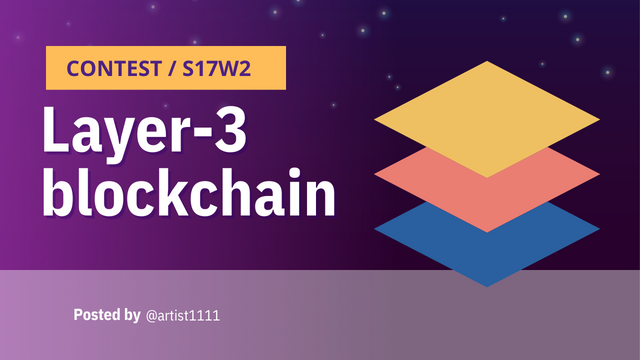Steemit Crypto Academy Contest / S17W2 : Layer-3 blockchain
Hello everyone! I hope you are all doing well and enjoying life with the blessings of Allah Almighty. I am happy to take part in the exciting challenge hosted by SteemitCryptoAcademy community . So, without any further delay, let's dive right in! Shall we ? ........, Okay , Okay😊! .
A "layer" in the context of blockchain architecture is a discrete functional level within the system as a whole. To ensure the smooth running of the whole blockchain network, each layer has a distinct function and communicates with the layers above and below it.
In order to provide modularity, scalability, and interoperability, the idea of layers is frequently utilized to arrange and structure the various parts of a blockchain system. Typically, layers consist of capabilities, protocols, and algorithms that are arranged according to the tasks and responsibilities they have in common.
Protocols, algorithms, and capabilities that are organized together according to their linked tasks and responsibilities are often included in layers. Collectively, these layers offer the agreement-based procedures, data storage, communication over the network, and transaction validation that make up the basis of the blockchain.
Layering the system makes it easier for developers to integrate it with other systems and protocols and allows for more productive design, implementation, and management of complex blockchain networks.
Describe the architecture of layer 3 blockchains specialized in fractal scalability, highlighting the main components and mechanisms that achieve this objective. Create a chart that illustrates this architecture. |
|---|
The functions and characteristics of a Layer 3 blockchain. Recall it as a multi-story skyscraper." All of the floors, or layers, collaborate to ensure the building runs efficiently. Each floor performs a certain purpose. Much of the magic in a Layer 3 blockchain occurs on the third floor, particularly in terms of providing the blockchain with increased flexibility and capacity to manage large numbers of users and transactions.
Fractal Scalability:
Now, let's talk about something called "fractal scalability." Imagine a tree with branches. Fractal scalability is like having smaller branches coming out of those bigger branches. It's all about making the blockchain more flexible and able to handle more users and transactions without getting bogged down or slowing down.
Main Components and Mechanisms:
So how does Layer 3 manage to scale in a cool fractal way? It functions something like a machine featuring multiple gears interacting. Interoperability is an important component to consider. That's just a fancy way of saying that data can be easily shared and communicated between various blockchains. This implies that data from one blockchain can be seamlessly transferred to another.
Achieving the Objective:
Smart contracts and decentralized apps, or dApps for short, are made possible by Layer 3, which is another important function. Digital agreements that take automated action when specific criteria are met are called smart contracts.
 Canvas design Canvas design | Components, mechanisms achieve scalable, dynamic growth. |
|---|
Moreover, decentralized apps that are or dApps, are similar to apps for smartphones except they are decentralized and run on the blockchain rather than being governed by a single entity. From games to finance, these elements increase the blockchain's adaptability and usefulness.
So, to put it briefly, Layer 3 blockchains are comparable to the blockchain equivalent of a superhero. For both developers and consumers, they unlock a world of possibilities, improve system performance, and handle increased traffic.
How do layer 3 blockchains specializing in fractal scalability use horizontal sharding to improve transaction processing capacity, and how does this differ from the Steem blockchain approach? |
|---|
Let's examine horizontal sharding in more detail and see how it makes Layer 3 blockchains able to process more transactions. Consider that you wish to cut a large cake into slices. Sharding is similar to chopping that cake into more digestible chunks. By slicing the cake smaller even smaller pieces, horizontal sharding goes a single step further and makes it easier to handle.
Improving Transaction Processing:
Thus, what is the benefit of horizontal sharding for transaction processing? Well, consider every piece of cake to be a collection of transactions. The blockchain may process every group separately by dividing them horizontally, much like multiple teams focusing on different aspects of a large project. This allows each team to concentrate on their portion without becoming overburdened, which expedites the entire process.
Different from Steem's Approach:
Let's now discuss how this varies from the Steem blockchain methodology. Steem's strategy is more akin to slicing a single, large cake into equal portions. Even though it can still handle interactions successfully this might not be as effective as horizontal sharding. The blockchain may adjust and grow more dynamically with horizontal the technique of processing even more transactions as needed.
Additional Ideas:
The ability of horizontal sharding to prevent bottlenecks is one of its amazing features. You can imagine the chaos that would result from every individual trying to use the same entryway at once. By creating many entrances, horizontal sharding facilitates more seamless transactions without inflicting traffic bottlenecks.
Everyone engaged will benefit from quicker times for processing and an improved user experience as a result. In conclusion, adding capabilities to the Layer 3 blockchain is the reason horizontal sharding is all about. By breaking up transactions into smaller, more manageable pieces, it speeds up and improves the efficiency of transaction processing.
Although Steem's method is still useful, horizontal sharding improves upon it by enabling the blockchain to process an even greater number of transactions with ease.
Explain how sidechains and rollups are essential elements of layer 3 blockchains to ensure fractal scalability, and how these concepts could be applied to the Steem blockchain to improve its performance. |
|---|
Prior to exploring the nuances of rollups and sidechains, it is critical to understand their basic principles and how they enable Layer 3 blockchains to effectively handle a multitude of activities.
These technologies provide the foundation for scalability, enabling blockchains to grow without sacrificing efficiency. Sidechains function as separate offshoots of the primary blockchain, and rollups optimize transactions for maximum efficiency.
 Canvas source Canvas source | Enhancing scalability with sidechains, rollups for Steem blockchain. |
|---|
As a dynamic pair, they allow blockchains to grow and adjust to growing demands while maintaining smooth operations and increased scalability.
Sidechains and Rollups Explained:
Consider sidechains to be the branches of a large tree. Every branch is free to operate independently of the main trunk. That is what sidechains are like; they are independent chains are are linked to the major chain so they are able to handle other applications or jobs without interfering with the main chain's speed.
Conversely, rollups are similar to rolling up a carpet to conserve room. They combine several transactions into one, which facilitates and expedites the processing of those transactions all at once.
Ensuring Fractal Scalability:
Let's now discuss the importance of sidechains and rollups in maintaining fractal scalability. Recall the large tree we discussed earlier. Indeed, the tree grows larger and stronger as additional branches sprout. Similar to rollups, sidechains enable the Layer 3 blockchain to expand and change in order to meet more users and transactions with ease.
This implies that the blockchain won't slow down or become clogged as it scaled up to meet the demands within the expanding digital world.
Applying to the Steem Blockchain:
How then might we apply these ideas to improve the Steem blockchain? What if there were sidechains dedicated to certain kinds of content, such as music or videos? These sidechains would let users to distribute their works without slowing down the main Steem blockchain.
Additionally, rollups allowed us to gather several likes and comments into a single transaction, which saved up and improved the efficiency of interacting with posts and updates. This would enhance the Steem blockchain's functionality, making it more responsive and seamless for all parties.
How do Layer 3 blockchains handle the challenges of decentralized governance while maintaining fractal scalability, and how does this compare to the governance structure of the Steem blockchain? |
|---|
Layer 3 blockchains must strike a compromise between the requirement for scalability and decentralized governance. It's similar to managing big businesses in that everyone has a voice, yet decisions still need to be made quickly.
Layer 3 blockchains frequently use consensus and voting mechanisms to address this. Imagine an extensive number voting to decide where to go on vacation. It's democratic, though the decision-making process can be drawn out.
It is difficult to maintain fractal scalability while addressing issues related to governance. It resembles attempting to juggle several balls at once while keeping none dropped. Blockchains with Layer 3 architecture do this by creating scalable governance mechanisms for expanding networks.
Even as more users join the network, they make sure that choices can be made swiftly and fairly by using sophisticated algorithms and protocols. Let's now contrast this with the Steem blockchain's governance system. Governance functions differently on Steem. Like in a small town, the majority of choices are made by a select group of important people.
Although this can occasionally be more effective, it can also result in conflicts of interest and power battles. On the other hand, Layer 3 blockchains strive for a more inclusive strategy in which all parties participate in the decision-making process.
How could the introduction of new technologies such as sharding and interoperable blockchains influence the future of layer 3 blockchains specialized in fractal scalability, and how could the Steem blockchain adapt to these developments? |
|---|
The potential influence of emerging technologies such as sharding and interoperable blockchains on Layer 3 blockchains, that are highly efficient in managing multiple activities, is significant.
Partitioning an undertaking into smaller, easier-to-manage segments is analogous to splintering. Distributing the workload among many groups enables these blockchains for processing even more transactions.
Conversely, interoperable blockchains function as akin to bridges joining disparate blockchains together. A multitude of opportunities for cooperation and creativity are made possible by their ability to facilitate smooth communication and information sharing across various networks.
The advent of sharding and interoperable blockchains has the potential to enhance the power and versatility of Layer 3 blockchains that specialize in fractal scaling. They would become even more responsive and efficient if they could manage even higher transaction volumes thanks to sharding.
These blockchains might communicate with other networks and share resources and capabilities to develop innovative and exciting applications if they were interoperable.
This might spark a wave of creativity as programmers use the combined advantages of several blockchains to produce ground-breaking products.
So, how could the Steem blockchain adapt to these developments? Well, it could embrace sharding to increase its transaction processing capacity, allowing it to handle more users and activities without slowing down.
Additionally, it could explore interoperability to connect with other blockchains, enabling users to access a wider range of services and assets. By adopting these new technologies, the Steem blockchain could position itself as a more scalable and interconnected platform, attracting new users and driving growth in its ecosystem.
Overall, the future looks bright for Layer 3 blockchains, with sharding and interoperability paving the way for exciting new possibilities and advancements.
With Best Regards
@artist1111
Goodbye, friends. It's been a pleasure getting to know you all participating in this community. I will miss interacting with all of you, but it is time for me to move on. Take care & I hope to see you all again very soon , Best of Luck .
As the sun sets on the day
And the night falls softly in
We close this chapter, dear reader
But the story's not yet done
Tomorrow's pages wait, unwritten
INTRODUCTION
As the sun sets on the day
And the night falls softly in
We close this chapter, dear reader
But the story's not yet done
Tomorrow's pages wait, unwritten
INTRODUCTION


Upvoted. Thank You for sending some of your rewards to @null. It will make Steem stronger.
TEAM 2
Congratulations! This post has been voted through steemcurator05. We support quality posts, good comments anywhere and any tags.Greetings @artist1111
Your explanation of layer 3 blockchains is seriously amazing. You made everything so easy to understand, and I am sure it took a lot of research to put such a wonderful publication. Good luck with the contest and all the best.
@artist1111 what an insightful dive into Layer 3 blockchain architecture! Your explanation of fractal scalability and horizontal sharding really clarified some complex concepts for me. I appreciate the clear breakdown of how these mechanisms work and how they could benefit the Steem blockchain. Best of luck in the contest
Absolutely, understanding the fundamentals is key. Sidechains operate parallel to the main blockchain, allowing for specific functions or applications to run independently, reducing congestion and increasing scalability. Rollups, on the other hand, bundle multiple transactions into a single one, minimizing the load on the main chain and improving efficiency without compromising security.
Your post is really great You have explained very informatively about the different layers of blockchain, which will make it easier for people to understand how layer 3 blockchains use fractal scalability. You have also explained very well how it is different from the structure of the Steem blockchain. Thank you for sharing this great information
Saludos gran amigo artist1111, un placer para mi saludarte y leer tu participación.
Felicitaciones por tan buen trabajo, la nota o la calificación lo demuestran, manejas muy bien el tema de las Blockchain de capa 3 y su funcionamiento.
Te deseo una feliz, bonita y bendecida noche.
Hey dear friend it's really lovely coming across your article once again you have meeting with so much dedication and quality that makes your post highly important and very education now to everyone who is in search of information on layer 3 work chain technologies and how to solve scalability issues faster.
Thank you very much friend for going through all the difficulties and stress just to come up with this quality article, on your free time I will appreciate you dropping a comment on my entry to the link below https://steemit.com/hive-108451/@starrchris/sec-s17-w2-or-or-layer-3-blockchain
Thank you so much for sharing your participation with us and I extremely agree with you that when we talk about STEEM then there is no side chain and roll-ups integration.But If we supposed to integrate both these elements in future at this blockchain then scalability would be improved at this blockchain and there will also be a level of enhancement in interoperability and increase level of efficiency of network So in this way there would be our diverse range of people that would attract by STEEM blockchain.
This is not bad if we think to integrate both these elements at STEEM Blockchain but still there is a need for considering it from different angles I really like your participation you wrote very well and try to delve into answer of all the questions.
Good luck 🤞